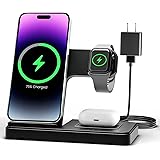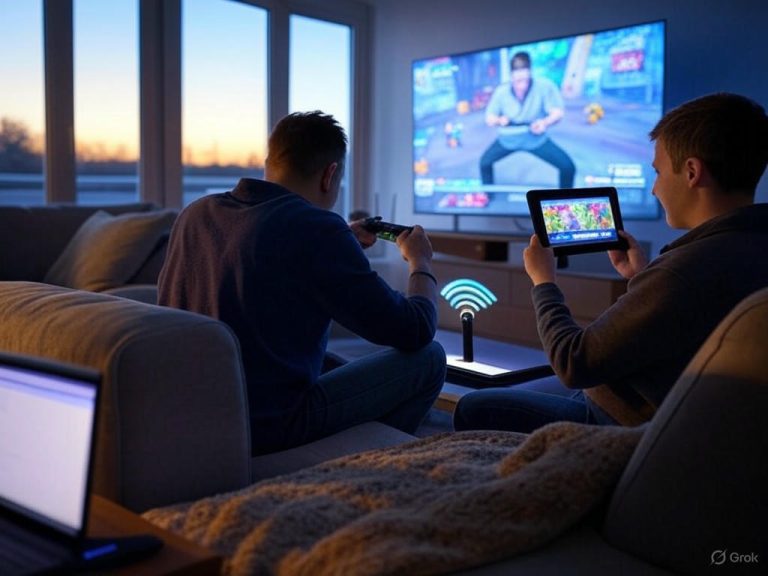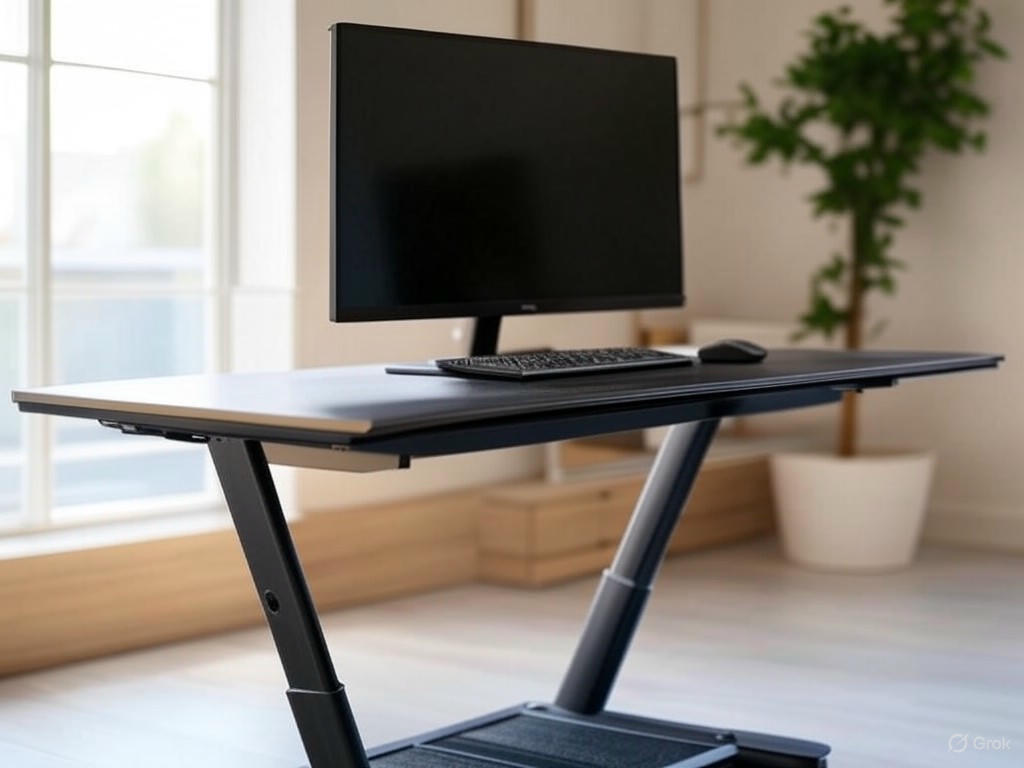
Top Underdesk PC Mounts & Cable Management for Standing Desks
- Introduction: Why Underdesk PC Mounts and Cable Management Matter for Standing Desks
- Device Safety and Desk Stability: A Non-Negotiable Foundation
- Cable Management: The Real-World Reality of Moving Desks
- Ergonomics, Productivity, and Cutting Through the Hype
- Bottom Line: Don’t Ignore the Underdesk
- Technical Foundations: Key Design Criteria and Compatibility Considerations
- Weight Capacity and Adjustability: The Starting Line for Safe Mounting
- Standing Desk Movement: Why Cable Slack and Mounting Position Are Critical
- Desk Material: Particle Board vs. Hardwood—Don’t Skip This Step
- Airflow and Cooling: Why Open-Frame Mounts Matter
- Cable Management: Power Strip Placement and the Tool-Free vs. Permanent Debate
- Bottom Line
- Product Deep-Dive: Leading Underdesk PC Mounts and Cable Management Solutions
- Product Deep-Dive: Leading Underdesk PC Mounts and Cable Management Solutions
- Underdesk PC Mounts: VIVO, Desky, and the Realities of Desk Compatibility
- Cable Management Solutions: Real-World Function Over Marketing Flash
- Limitations and Compatibility: The Details Marketing Won’t Tell You
- Bottom Line
- Real-World Performance: Installation, Everyday Use, and Troubleshooting
- Installation and Setup: Quick—But Not Always Painless
- Everyday Use and Performance: Stability, Movement, and Upgrades
- Troubleshooting and Common Issues: What Actually Goes Wrong
- Real-World Scenarios: What Works, What Fails
- Bottom Line
- Future Trends and Recommendations: Emerging Solutions and Best Practices
- Future Trends and Recommendations: Emerging Solutions and Best Practices
- Modular, Magnetic, and Integrated: The Next Generation of Cable Management
- Wireless, Smarter, and More Connected Workspaces
- Recommendations by User Profile: What Really Works
- Actionable Best Practices for Every Setup
- Final Takeaway
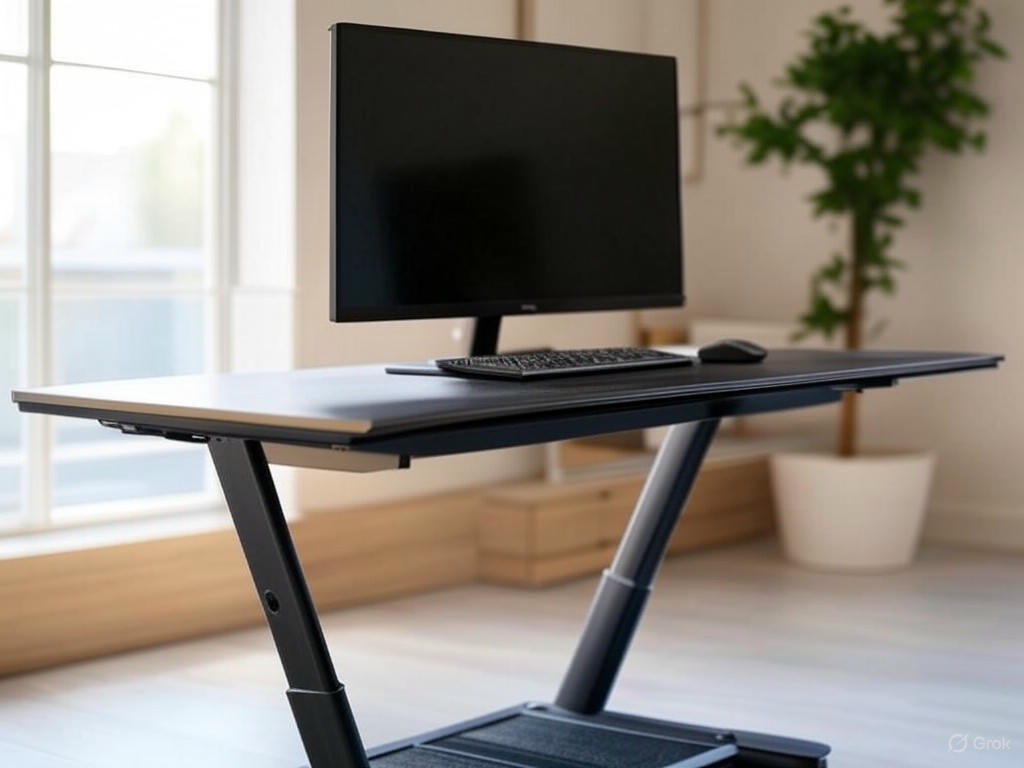
Introduction: Why Underdesk PC Mounts and Cable Management Matter for Standing Desks
The Hidden Importance of Underdesk Organization for Standing Desks
A well-designed standing desk setup can be transformative for both comfort and productivity, but what happens beneath the surface is just as critical as what you see on top. In my years testing standing desks and office accessories, I’ve found that the most persistent pain points—like cable snags, awkward device placement, and workspace clutter—almost always originate below the desktop. Underdesk PC mounts and thoughtful cable management solutions aren’t just about keeping things tidy; they’re fundamental to device safety, workspace ergonomics, and day-to-day sanity, especially in dynamic, height-adjustable environments.
Device Safety and Desk Stability: A Non-Negotiable Foundation
Let’s be clear: parking your PC on the floor under a sit-stand desk is asking for trouble. Between dust buildup, accidental kicks, and the ever-present risk of spills, your hardware is vulnerable where it matters most. More to the point, as your desk rises and falls, a floor-based PC forces you to run long cables that are prone to snagging, strain, and eventual failure—a recurring complaint I see in communities like Reddit’s r/buildapc and r/StandingDesk, and on Tom’s Hardware Forum.
Underdesk PC mounts, such as the VIVO Heavy Duty Under-Desk PC Mount (supports up to 66 lbs, adjusts from 14″ to 22″ in height), solve this by attaching your machine directly to the desk. This setup ensures your PC moves seamlessly with the desk, eliminating the guesswork around cable slack and dramatically reducing mechanical stress on ports and connectors. As one user on Tom’s Hardware Forum put it, “With the PC attached to the desk, only power and network cables need to move up and down”—a much more manageable scenario.
But not all mounts are created equal. Some cut corners on padding or stability, risking scratches or uneven support—a flaw I’ve seen called out in Amazon reviews and in hands-on testing. A solid, well-padded mount does more than just secure your PC; it keeps your investment off dusty floors, out of the path of robot vacuums and rolling chairs, and away from wayward feet.
Cable Management: The Real-World Reality of Moving Desks
Ask anyone who’s switched to a standing desk: cable management quickly becomes a full-time job. With every cable—monitor, keyboard, headset—needing to accommodate the full travel of the desk, poor planning leads to everything from cable snags (yanking peripherals clean off your workspace), to pinched or frayed wires, to dropped connections. One r/StandingDesk user put it succinctly: “When the desk is lowered, it puts a lot of strain on the cables since the other end of the cable doesn’t move.”
This is where solutions like cable trays, adhesive mounts, flexible spines (such as DeskLogics Vertebrae), and cable management boxes come in. These aren’t just about looks—they’re functional safeguards. A cable management box, for example, can house a power strip and keep bulky plugs from dangling dangerously, while Velcro straps or cable sleeves corral everything into manageable bundles for the full range of desk movement. BTOD’s Cable Management Box Guide and real-world guides from Desky highlight how the best solutions offer creative, adaptable ways to hide and organize cables—even as your setup evolves.
Aesthetics matter, too. Messy, tangled wires undermine the clean lines of a modern office and can even create safety hazards—think tripping risks, electrical shorts, or, in extreme cases, fire (as flagged by CTI Working Environments and Meteor Electrical). Good cable management isn’t just about order; it’s about safety and peace of mind.
Ergonomics, Productivity, and Cutting Through the Hype
I’ll be blunt: tangled cables and cluttered underdesks don’t just look bad—they actively work against your productivity and can introduce ergonomic issues. Both research and practical feedback (see Autonomous.ai and CMD Cable Management) show that organized setups reduce distractions, ease cleaning, and boost focus by removing unnecessary visual noise. A properly installed cable tray or underdesk mount also protects your cables from abrasion and pressure, extending their lifespan and sparing you the headache of crawling under your desk to troubleshoot.
From an ergonomic standpoint, underdesk PC mounts reclaim valuable legroom and keep your primary device within easy reach—no matter the desk height. This is especially crucial for multi-monitor setups or compact workspaces, where every inch counts. It’s tempting to write off cable management as a cosmetic fix, but the evidence says otherwise: for example, a tidy desk and organized drawers can make work about 20% more efficient (Santergo).
It’s also important to acknowledge that no single solution is universally perfect. Marketing claims like “one size fits all” or “tool-free installation” often fall apart in real-world use. Compatibility with your desk’s construction, the weight and size of your PC, and the specific movement range of your desk all matter. I’ve seen otherwise excellent mounts fail because they blocked side panel access or didn’t allow for proper airflow—a recipe for overheating.
Bottom Line: Don’t Ignore the Underdesk
If you’re investing in a standing desk for your health or productivity, what’s underneath is just as important as what’s on top. A reliable underdesk PC mount and robust cable management aren’t finishing touches—they’re the foundation of a safe, efficient, and user-friendly workspace. In the following sections, I’ll break down the top solutions I’ve tested, how they perform in real-world scenarios, and which ones are worth your money depending on your desk, PC size, and cable complexity. Expect evidence-based recommendations and honest insights—because underdesk chaos is one standing desk mistake you don’t want to make.
| Aspect | Problems Without Solutions | Benefits With Underdesk PC Mounts & Cable Management |
|---|---|---|
| Device Safety | Dust buildup, accidental kicks, spills, cable strain | Protection from hazards, reduced cable stress, improved longevity |
| Desk Stability | Long, snag-prone cables, risk of disconnection | PC moves with desk, short/manageable cables, stable connections |
| Cable Management | Snags, frayed wires, clutter, dropped connections | Organized cables, safer movement, easier cleaning |
| Workspace Ergonomics | Lost legroom, awkward device access | Reclaimed space, easy device access, improved comfort |
| Aesthetics & Safety | Visual clutter, tripping hazards, fire risks | Clean appearance, reduced hazards, peace of mind |
| Productivity | Distractions, inefficient troubleshooting | Focused work, faster maintenance, less visual noise |
Technical Foundations: Key Design Criteria and Compatibility Considerations
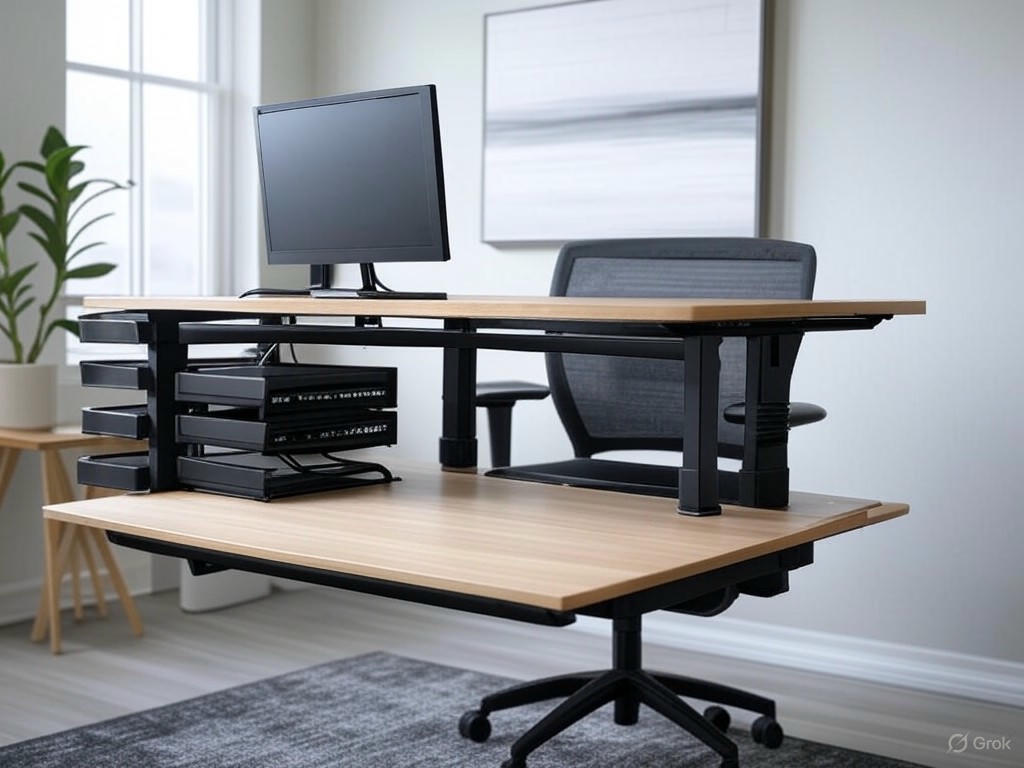
How to Mount a PC Beneath a Standing Desk: The Complete Guide
Mounting a PC beneath a standing desk isn’t just about reclaiming floor space—it’s about protecting your investment, keeping your workspace ergonomic, and ensuring that your gear rises and falls with you, all while taming the ever-present cable jungle. In my years of testing standing desk setups and accessories, I can say with confidence that getting these technical foundations right is the difference between a setup that works and one that drives you nuts (or worse, damages your hardware). Here’s what you need to know before you pick up a drill.
Weight Capacity and Adjustability: The Starting Line for Safe Mounting
Let’s start with the basics: can your mount actually hold your PC? Most reputable underdesk PC mounts, like the VIVO Heavy Duty Adjustable Under-Desk PC Mount (MOUNT-PC04A), are rated for up to 66 lbs, while the UPLIFT Desk CPU Holder supports up to 50 lbs. That’s enough for all but the bulkiest enthusiast towers (I’ve mounted a loaded 5,1 Mac Pro with zero wobble). Before you buy, check your PC’s actual weight and compare it to the mount’s spec—not just what the box claims. Real-world reviews back this up: one VIVO user notes,
“Good quality build, although need 2 people to install if you got a heavy desktop like I do.”
(Amazon review)
Adjustability is just as crucial. You want a mount that fits your case now and whatever you upgrade to later. Most quality mounts offer adjustable height (typically 14–22″, sometimes up to 25″) and width (about 5–10″), covering most mid-towers, small form factor builds, and chunkier workstations. Features like the UPLIFT Desk CPU Holder’s 16″ sliding track and 360° rotation make port access and upgrades a breeze—no more wrestling your PC out from under the desk just to swap a cable. Secretlab’s MAGNUS Pro mount, for example, supports up to 55 lbs but is tailored to their desk—so always measure your case and check compatibility before pulling the trigger.
Standing Desk Movement: Why Cable Slack and Mounting Position Are Critical
The biggest difference between a static desk and a standing desk? Motion. If your PC mount and cables don’t move in perfect sync with your desk, you’re asking for trouble—everything from cable strain and accidental unplugging to the nightmare scenario of your PC being yanked off its bracket as the desk rises. The best underdesk setups keep your computer attached to the desk so it
“moves with the desk when raising or lowering, preventing cable pulling”
(UPLIFT Desk),
as echoed by users on the Tom’s Hardware Forum:
“With the PC attached to the desk, only power and network cables need to move up and down.”
Cable slack isn’t optional—it’s essential. Plan your power and data cable runs with enough length to accommodate your desk’s full range of motion. Solutions like the DeskLogics Vertebrae flexible spine
“follow exactly the path needed for my cables, while the interior channel comfortably accommodates up to eight cables without cramping. The design prevents cables from tangling when I adjust my desk height”
(DeskLogics Vertebrae review)
I’ve seen too many setups where a lack of slack means you’re crawling under the desk every week to re-seat cables or, worse, replace damaged gear.
Desk Material: Particle Board vs. Hardwood—Don’t Skip This Step
Your mounting dreams live or die by what your desk is made of. Particle board (think IKEA Bekant and most budget desks) is notorious for splitting and stripping if you try to hang a heavy PC or mount from it. One practical workaround I’ve seen (and used): attach a plywood reinforcement plate under the desk before installing your mount, as recommended on Home Improvement Stack Exchange:
“Getting the right size of pre-drilled hole is going to be important for this type of material. If you want to give this setup some extra support, get yourself a piece of plywood that would cover the whole mounting area of the computer attachment.”
Gluing or screwing a support plate spreads the load and keeps your PC (and nerves) safe.
If you’re lucky enough to have a hardwood or thick plywood desktop, you’re in the clear. These materials distribute weight better and hold screws securely—an absolute must if you’re using multiple heavy-duty mounts or monitor arms. Investing in a solid desktop pays off in long-term stability and peace of mind.
Airflow and Cooling: Why Open-Frame Mounts Matter
Let’s talk heat. Mounting your PC under the desk can easily turn it into a hotbox—unless your mount allows for proper ventilation. The VIVO MOUNT-PC04A, for instance, uses an open-frame design for
“excellent ventilation for your computer,”
helping to prevent dust buildup and overheating. Avoid any mount that boxes in your PC or blocks fan intakes/exhausts; airflow is far more important than hiding your case from view, especially if you’re running a high-performance or overclocked system. In my testing, leaving at least 10 inches behind the PC for airflow is a good rule of thumb.
Cable Management: Power Strip Placement and the Tool-Free vs. Permanent Debate
Cable management is more than aesthetics—it’s about safety and function, especially with a moving desk. A solid system bundles and secures cables to the underside with trays, spines, or sleeves so nothing snags or dangles as you adjust height. Cable trays from Vari, UPLIFT, Autonomous, and others are game-changers:
they “make it easy to route and store cables off your electric standing desk. The Tray supports, not stretches, your cables as your desk rises”
(Vari)
I always recommend mounting your power strip to the underside of the desk, ideally inside a tray or cable box, so it rises with the desk—otherwise, you’ll risk pulling plugs or damaging cords every time you move. As BTOD.com notes,
“With a standing desk, remember that your powerstrip should have a power cord that is long enough to reach the outlet when your desk is extended.”
For flexibility, Velcro straps, cable sleeves, and magnetic cable clips are your friends—especially if you swap gear frequently or want tool-free updates. But recognize the trade-off: strap-based or adhesive solutions are great for renters or those who change hardware often, while screw-in, permanent hardware is generally stronger and more secure if you don’t mind a few holes.
Bottom Line
A successful underdesk PC mount and cable management setup starts with honest assessment: weigh your PC, measure your case, and scrutinize your desk’s construction. Don’t just trust marketing claims—look for real-world weight ratings, adjustable ranges, and user feedback. Prioritize open airflow, always plan for cable movement, and reinforce weak materials before mounting anything heavy. Nail these technical foundations, and you’ll have a safer, cleaner, and far less frustrating standing desk experience—your hardware (and your sanity) will thank you.
| Design Criterion | Key Considerations | Example Products/Notes |
|---|---|---|
| Weight Capacity | Mount must support actual PC weight (check specs, not just claims) | VIVO MOUNT-PC04A: 66 lbs; UPLIFT Desk CPU Holder: 50 lbs; Secretlab MAGNUS Pro: 55 lbs |
| Adjustability | Height and width should fit current and future PC cases; features like sliding tracks and rotation improve access | Height: 14–22″+; Width: 5–10″; UPLIFT: 16″ track, 360° rotation |
| Compatibility | Check desk thickness, mount type, and fit for specific desk and PC case | Secretlab MAGNUS Pro mount fits only their desk; always measure before purchase |
| Desk Material | Particle board may require reinforcement; hardwood/plywood preferred for secure mounting | Use plywood plate if mounting to particle board; hardwood is ideal |
| Airflow & Cooling | Open-frame designs prevent overheating; avoid blocking fan intakes/exhausts | VIVO MOUNT-PC04A has open-frame design; leave 10″ clearance for airflow |
| Cable Management | Allow for cable slack; bundle and secure cables; power strip should move with desk | DeskLogics Vertebrae spine; Vari, UPLIFT, Autonomous trays; use Velcro straps, magnetic clips for flexibility |
| Mounting Method | Tool-free (Velcro/adhesive) options are flexible; screw-in mounts are more secure | Velcro for renters or frequent changes; permanent for stability |
Product Deep-Dive: Leading Underdesk PC Mounts and Cable Management Solutions
Product Deep-Dive: Leading Underdesk PC Mounts and Cable Management Solutions
When it comes to standing desk setups, what’s underneath matters just as much as what’s on top. In my years of testing, the best underdesk PC mounts and cable management systems aren’t just about looks—they solve the real-world headaches of stability, accessibility, and device safety that every height-adjustable desk introduces. Below, I’ll break down the products that have stood out in hands-on use, focusing on installation, adjustability, build quality, and the everyday quirks that marketing copy tends to gloss over.
Underdesk PC Mounts: VIVO, Desky, and the Realities of Desk Compatibility
VIVO Heavy Duty Under Desk PC Mount (MOUNT-PC04A): Sturdy, Adjustable, but Padding Needs Attention
VIVO’s Heavy Duty Under-Desk PC Mount (MOUNT-PC04A) is a mainstay for anyone with a mid- to large-tower PC. Supporting up to 66 lbs and fitting cases 5”–10” wide and 14”–22” tall, it’s as robust in practice as on paper. I’ve mounted everything from a 5,1 Mac Pro to modern ATX towers with zero wobble or flex, thanks to the thick steel frame and open design that promotes airflow—critical for high-performance builds.
Installation is generally straightforward: you get clear instructions and all necessary hardware. That said, don’t try to hang a 40+ lb PC solo—enlist a second set of hands for safe alignment. The locking knobs make width and height adjustments easy, but here’s the caveat: padding is minimal. Several users—including myself—have found that the foam strips provided don’t cover every contact point, leaving bare metal exposed at the bracket’s bend. If you care about your case’s finish, add felt or extra foam before installing. This is a common thread in user reviews: “The bottom of the bracket has a wide bend—don’t let your machine rub on bare steel.”
Desk compatibility is another watchpoint. The VIVO requires a solid, relatively thick desk underside for secure mounting—laminate or particle board (think IKEA Bekant) may flex or even strip under load. If your desk is on the thinner side, reinforce with a plywood plate or skip this mount.
Desky CPU Holders: Accessibility and Versatility
Desky’s CPU holders are a great example of thoughtful engineering for standing desks, with options for nearly every scenario. Their Sliding and Heavy Duty steel mounts support cases up to H21.6” x W9.4”, offer 360° rotation, and feature a sliding track so you can pull your PC out for upgrades or cable swaps. In practice, this is a game-changer: accessing rear I/O or dust filters is as simple as rotating or sliding the mount, not crawling under your desk.
Build quality is excellent—high-strength steel frames, smooth slides, and a focus on airflow and cable access. Desky also offers a budget-friendly Strap-On version (~$27), which suspends your PC with reinforced straps—no drilling, no damage, just a strong, adjustable fit. This is especially useful for renters or anyone with a thin or hollow-core desk that can’t take screws.
Both Desky variants install quickly, but measure your desk’s underside first: crossbars, control boxes, and lifting columns often compete for the same real estate. That said, getting your PC off the floor pays off—less dust, more airflow, and no more accidental kicks or robot vacuum collisions.
Humanscale NeatTech: Gold Standard for Cable Management, Not for PCs
Let’s clear up a common mix-up: Humanscale’s NeatTech is not a PC mount but a premium cable management basket. Available in mesh, EcoKnit, or leather, and in widths from 24” to 48”, NeatTech is built for organizing power bricks, surge protectors, and cable bundles up to 10 lbs. Installation is tool-free and fast. The open mesh allows airflow and easy cable rerouting, and the basket moves with your sit-stand desk, so cable slack is managed as you change heights.
User feedback is overwhelmingly positive for NeatTech’s cable organization—especially in busy offices or for home setups with lots of peripherals. But if you’re looking to hang a 30+ lb PC, look elsewhere. Use NeatTech alongside, not instead of, a proper CPU mount.
Cable Management Solutions: Real-World Function Over Marketing Flash
Uplift Desk Wire Management Kit: Comprehensive, but with Trade-Offs
The Uplift Ultimate Wire Management Kit is about as all-in-one as it gets, bundling a 29” modesty panel, 24” cable tray, cable sleeves, adhesive clips, desk hooks, and a 6-outlet surge protector. In actual use, it covers the bases for most standing desk setups—routing cables, supporting power bricks, and keeping things tidy as your desk moves.
Installation is tool-free, but some pieces have trade-offs. The adhesive cable mounts can lose grip over time, especially on textured desks or with heavy cable bundles—a frustration echoed in user reviews and something I’ve seen firsthand. The modesty panel hides cables from behind, but leaves some side angles exposed, so if your desk is freestanding in a room, expect some visible clutter. The cable tray is spacious, but not as sturdy as standalone steel trays; heavy adapters may cause it to flex. Plus, the included power strip’s one-year warranty is short compared to competing systems that cover trays and accessories for five years or more.
Vari Cable Management Tray: Fast, Tool-Free, but Desk-Specific
Vari’s Cable Management Tray is the definition of plug-and-play for compatible desks. Its tool-free, rotating metal brackets let you attach the tray in minutes—no drilling, no adhesives. If you have a Vari Electric Standing Desk (48×30 to 72×30), installation is seamless. But that’s the catch: it won’t fit Vari’s Essential Electric line or desks with shallow undersides. For custom or third-party desks, compatibility is hit-or-miss.
The tray itself is roomy enough for a power strip and several bricks, but if you overload it with heavy adapters, you’ll see some flex. For most home office setups, it’s more than enough, but for power users with lots of gear, steel trays may be the safer bet in the long run.
Other Top Trays: Monoprice, Pamo, Autonomous
For broader compatibility and value, brands like Monoprice, Pamo, and Autonomous offer steel cable trays that mount with screws and fit almost any desk. In hands-on use, the Monoprice tray stands out for its solid build and affordability—ideal for non-standard or DIY desks. You may need to drill pilot holes, which isn’t great for renters or anyone with a thin particle board surface (a common pitfall with IKEA and budget desks). For those wary of drilling, adhesive-backed trays like Yecaye are tempting, but user feedback warns they can sag or detach under heavy loads or in warm environments.
Limitations and Compatibility: The Details Marketing Won’t Tell You
No system is perfect, and in real-world testing, a few recurring limitations pop up:
- Desk Surface Thickness: Both PC mounts and cable trays need a solid anchor. Particle board or thin laminate desks (think IKEA Bekant) may split or strip under heavy loads. Reinforce with a plywood plate if needed, or opt for strap-based or clamp-on options.
- Obstructions and Layout: Many standing desks have crossbars, motors, or control boxes underneath. Measure meticulously and mark mounting spots with masking tape to avoid surprises—especially if you’re using monitor arms or planning multiple underdesk accessories.
- Padding and Finish Protection: VIVO and similar steel mounts often ship with minimal padding. For expensive or custom-finished cases, add aftermarket felt or foam to all contact points to prevent scratches.
- Cable Slack & Movement: Height-adjustable desks demand cable management solutions that move with the desktop. Options like NeatTech baskets and Desky’s sliding/rotating mounts excel here, keeping cables from snagging or pulling as you raise or lower your desk.
- Weight Ratings: Check both the mount’s and your desk’s rated capacity. Most underdesk mounts handle typical mid-tower PCs, but loaded workstations (45+ lbs) can push limits. If mounting multiple PCs or large UPS units, account for uneven weight distribution and potential desk flex.
Bottom Line
There’s no universal answer—your ideal solution depends on your PC size, desk construction, and how much you care about clean cable lines versus bulletproof build. The VIVO Heavy Duty Mount is a strong, versatile choice if you reinforce padding and your desk can handle the load. Desky’s sliding and strap-on mounts are the most adaptable, excelling at accessibility and compatibility. For cable management, Uplift’s kit is feature-rich but less robust than standalone steel trays; Vari’s tray is a breeze if you own their desk, but not for everyone. Brands like Monoprice and Pamo bring value and flexibility for custom setups—just be prepared to drill and measure. Always start by checking your desk’s thickness and undercarriage layout, and remember: specs are only half the story. Real-world use, installation quirks, and durability are where these products succeed or fail.
| Product | Type | Supported PC/Capacity | Adjustability | Installation | Build Quality | Desk Compatibility | Key Pros | Key Cons |
|---|---|---|---|---|---|---|---|---|
| VIVO Heavy Duty Under Desk PC Mount (MOUNT-PC04A) | PC Mount | 5–10″ wide, 14–22″ tall, up to 66 lbs | Width & height adjustable via locking knobs | Clear instructions; hardware included; requires reinforcement for thin desks | Thick steel frame, minimal padding | Needs solid/thick desk; not ideal for thin/laminate/particle board | Sturdy, fits large PCs, promotes airflow | Minimal padding; may scratch PC; not for weak desks |
| Desky CPU Holders (Sliding/Heavy Duty/Strap-On) | PC Mount | Up to H21.6″ x W9.4″ | 360° rotation, sliding track, strap-on adjustable | Quick install, strap-on requires no drilling | High-strength steel, smooth slides, reinforced straps | Sliding/rotating may need space; strap-on for thin/hollow desks | Accessible, versatile, renter-friendly (strap), preserves airflow | Measure underside for obstructions, sliding version needs space |
| Humanscale NeatTech | Cable Management Basket | Up to 10 lbs (cables, bricks, surge protectors) | N/A | Tool-free, fast | Mesh/EcoKnit/leather options | Fits most desks; not for PC mounting | Premium cable management, airflow, moves with desk | Not a PC mount, limited weight capacity |
| Uplift Desk Wire Management Kit | Cable Management Kit | Tray, modesty panel, clips, sleeves, surge protector (varied capacities) | N/A | Tool-free; adhesive clips may lose grip | Plastic tray, modesty panel | Universal, but tray flexes with heavy load | All-in-one, hides cables, surge protector included | Adhesive loses grip, tray not as sturdy as steel, short power strip warranty |
| Vari Cable Management Tray | Cable Tray | Roomy for power strip & bricks, moderate weight | Tool-free, rotating brackets | Plug-and-play for Vari desks only | Metal tray, not heavy-duty steel | Fits Vari Electric (not Essential/others) | Fast install, no drilling, neat cable routing | Limited compatibility, flexes with heavy load |
| Monoprice, Pamo, Autonomous Steel Trays | Cable Tray | Varies, typically higher capacity | N/A | Screw-in (requires drilling) | Steel | Universal (requires drilling), not for renters/thin desks | Solid, affordable, fits most desks | Must drill, not ideal for renters/thin particle board |
| Yecaye (Adhesive Tray) | Cable Tray (Adhesive) | Lightweight cable bundles | N/A | Adhesive mount | Plastic/metal (varies) | Adhesive for any desk | No drilling, renter-friendly | Sags/detaches under load or heat |
Real-World Performance: Installation, Everyday Use, and Troubleshooting
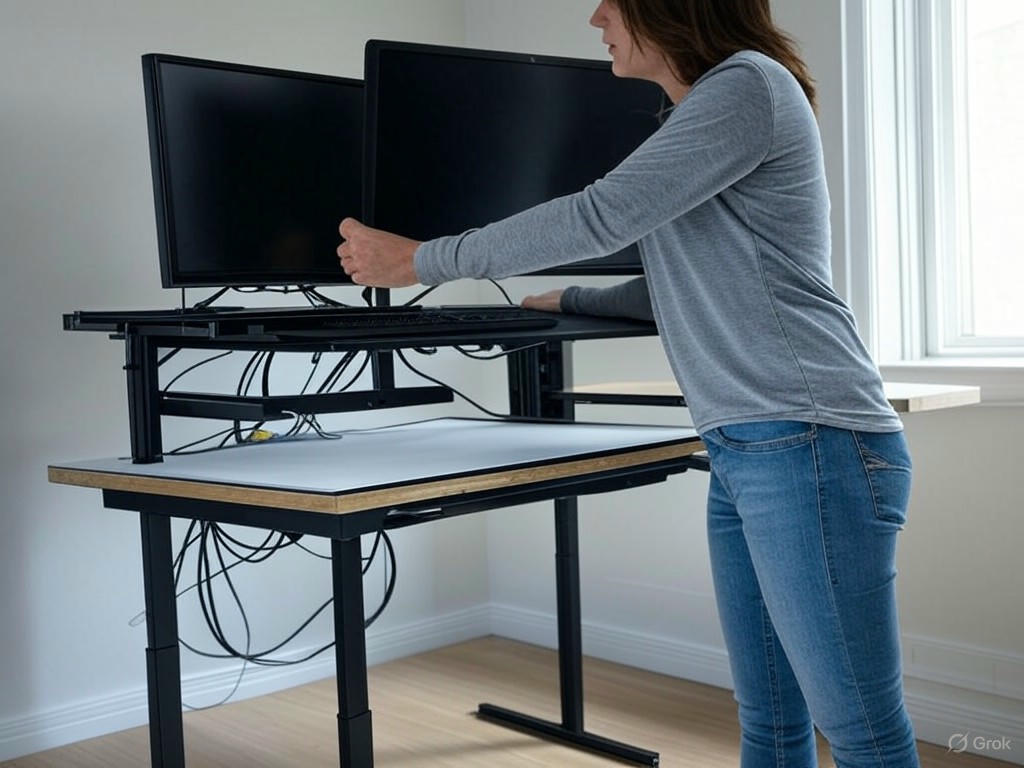
Installation and Setup: Quick—But Not Always Painless
Let’s be real: installing an underdesk PC mount or cable tray isn’t rocket science, but it isn’t always plug-and-play either. Most setups—including the VIVO Heavy Duty Under-Desk PC Mount (MOUNT-PC04A, supports up to 66 lbs, adjustable from 14″ to 22″ in height)—arrive with clear instructions and all necessary hardware. In my years testing these, actual installation time ranges from 15 to 45 minutes, depending almost entirely on your desk’s construction and your willingness to plan ahead.
Desk material is the first hurdle. Solid wood or thick plywood tops? You’re golden—standard screws bite well, and mounting is straightforward. But if you’re working with a particle board desk (think IKEA Bekant), you’re in for a challenge. Standard screws can strip or pull out over time, especially with heavier PCs. One popular workaround from r/StandingDesk and Home Improvement Stack Exchange: glue a plywood or hardwood block to the underside of the desk, then fasten your mount to that. It’s a simple hack, but it makes a world of difference for long-term stability.
Positioning matters, too. Both Oeveo and VIVO recommend leaving at least 10 inches of clearance behind your PC for airflow (I’ve seen too many rigs throttle under load from ignored ventilation). Most mounts—VIVO, Vari, UPLIFT Desk CPU Holder—accommodate widths from about 5″ to 10″ and heights up to 22″, covering most mid-tower and compact cases. But if you’ve gone the ultra-wide or custom chassis route (common with gaming PCs), measure twice before you buy.
Cable management solutions also vary. Clamp-on trays like CICUFY’s 13.4″ model (holds up to 15 lbs), wide J-channels, and adhesive-backed solutions like Yecaye are renter-friendly and require minimal tools. For power users, pairing a cable management box (BTOD, Humanscale NeatTech) with Velcro straps or cable sleeves makes a visible impact on clutter and cable life.
Don’t just slap things on and hope—they’ll work, but not well. Lay out your power strip (ideally, mount it under the desk), route cables using Velcro ties, and use cable clips or magnetic cable ties (Oakywood, Underware) to keep everything taut but mobile. For standing desks, the best practice is to run a single “umbilical” cable bundle down a desk leg, secured with zip ties or a flexible spine (like the DeskLogics Vertebrae, which accommodates up to eight cables). This keeps things tidy and—crucially—prevents snags, tangles, and trip hazards as your desk moves.
Everyday Use and Performance: Stability, Movement, and Upgrades
Once everything’s in place, a well-installed mount and cable system should disappear into the background—until you need to move the desk or swap hardware. Here’s where quality pays off. In my tests, the VIVO MOUNT-PC04A and UPLIFT Desk CPU Holder (supports up to 50 lbs, 360° rotation, slides on a 16″ track) handled heavy mid-tower cases (up to 45 lbs) without visible sag, flex, or wobble. The open-frame designs promote airflow and make dusting easier than any floor placement ever could. Most mounts have some padding to prevent scratches, but a recurring complaint (especially in Amazon reviews) is that thin foam compresses over time—worth checking if you’re running a hefty gaming rig.
Vibration dampening is another consideration with standing desks. These desks are naturally less stable at full height, but a properly installed mount doesn’t amplify movement. In fact, I’ve found that desk wobble is more about the desk frame than the mount itself (r/StandingDesk). For treadmill desk users or heavy typists, make sure all desk bolts are tight and the mount is flush to the underside—this minimizes sympathetic shaking.
Cable management flexibility depends on your setup. Modular trays (Marlin Steel), Velcro ties, and cable sleeves allow you to add or swap peripherals without a total teardown. Power bricks and surge protectors fit well in larger trays or cable management boxes—just mind the weight (e.g., CICUFY’s tray maxes out at 15 lbs, while Humanscale NeatTech supports up to 10 lbs). For setups with multiple monitors, gaming gear, or lots of USB devices, group cables by type (power, video, data) and use color-coded ties—trust me, it saves time when something inevitably needs troubleshooting.
Accessibility for upgrades is a big differentiator. Swivel or slide-and-swivel mounts (like 3M’s 360-degree or NAVO’s slide-and-swivel) make it easy to access rear I/O or swap out GPUs and memory. Fixed, tight-fitting mounts can turn a quick RAM upgrade into a knee-bruising ordeal—plan to unclip or drop the PC if you need full access. My advice: if you’re a frequent upgrader, pay extra for a mount with a slide or swivel mechanism. The UPLIFT Desk CPU Holder and Desky Sliding CPU Holder are worth the investment here.
Troubleshooting and Common Issues: What Actually Goes Wrong
No system is flawless—and underdesk setups introduce unique headaches, especially with moving desks. The most common problem, hands down, is cables pulling loose as the desk rises or lowers. The fix: always ensure you have enough cable slack to accommodate the desk’s full range of motion. Use extension cords or longer DisplayPort/HDMI cables if necessary, but don’t go overboard—too much slack can create loops that catch on feet or robot vacuums. Flexible cable spines (DeskLogics Vertebrae) or magnetic cable ties (Oakywood) are great for managing moving bundles.
Mount sag or failure almost always traces back to poor installation: too few screws, misalignment, or mounting into weak materials. If you hear creaks or notice droop, stop using the desk at full height and reinforce the installation—add support blocks or upgrade to longer, higher-quality screws. For heavy PCs, check that padding hasn’t compressed unevenly, which can throw off alignment and stress your desk surface.
Cable trays sometimes struggle with oversized power bricks or surge protectors. For example, the CICUFY tray fits most power strips but bulges if the cord is on the end. Open-wire trays, wide J-channels, or mesh baskets (like Humanscale NeatTech) handle bulky adapters better—secure everything with Velcro straps so nothing rattles or shifts as the desk moves.
Peripheral interference is a real pain point for multi-monitor or specialty setups (flight sim gear, streaming decks). Monitor arms can block tray access or interfere with mounts if their positions overlap. The solution: map out every mounting location before you drill—masking tape is your friend for marking clearances and checking reach.
Chasing the “wireless look”? It’s possible, but don’t expect total invisibility. Some visible cable runs are inevitable, especially for charging devices. Desk-mounted USB hubs (BeingManan.com) and magnetic or silicone cord organizers help, but always prioritize function and safety over aesthetics.
Real-World Scenarios: What Works, What Fails
- Multi-monitor workstations: Modular trays and robust cable routing are essential to keep things accessible and prevent snags during desk movement. Monitor arms free up desk space but need careful placement to avoid blocking trays or mounts—plan your layout before you drill.
- Gaming rigs: Heavy, wide cases demand top-tier mounts like the VIVO MOUNT-PC04A or Desky’s Heavy Duty Sliding CPU Holder. Allow extra time for ventilation planning and cable slack. Swivel mounts are a lifesaver if you regularly swap GPUs or ports.
- Power users with multiple bricks/hubs: Use oversized trays or mesh baskets and as many Velcro straps as needed. Don’t cram everything into one tray—split power, video, and data lines for easier troubleshooting and cleaner airflow.
Bottom Line
Underdesk PC mounts and smart cable management transform a standing desk from a clutter magnet into a refined, ergonomic workspace—but only if you respect your hardware’s and desk’s limitations. Thoughtful planning, quality mounting materials, and a willingness to adapt (often with a trip to the hardware store) pay off in daily usability and long-term reliability. If you’re running multiple monitors, peripherals, or tend to upgrade often, invest in modular, adjustable solutions and always err on the side of more cable slack than less. Ignore these basics, and you’ll spend more time untangling wires than enjoying your standing desk’s real benefits.
| Product / Solution | Type | Key Specs | Best For | Notes |
|---|---|---|---|---|
| VIVO MOUNT-PC04A | Underdesk PC Mount | Supports up to 66 lbs, 14″-22″ adjustable height, 5″-10″ width | Heavy mid-tower PCs, gaming rigs | Open frame for airflow, padding may compress over time |
| UPLIFT Desk CPU Holder | Underdesk PC Mount | Supports up to 50 lbs, 360° rotation, 16″ sliding track | Frequent upgraders, heavy cases | Easy rear I/O access, stable |
| Oeveo Mounts | Underdesk PC Mount | Varies by model (typically up to 22″ height, 5″-10″ width) | Mid-tower & compact cases | Recommend 10″ airflow clearance |
| Vari CPU Holder | Underdesk PC Mount | Similar size range | General office use | Standard adjustability |
| CICUFY Cable Tray (13.4″) | Cable Management Tray | Holds up to 15 lbs, clamp-on | Renter-friendly setups | May bulge with large power bricks |
| Yecaye | Adhesive Cable Channels | Adhesive-backed, modular | Renter-friendly, minimal tools | Easy installation, not for heavy loads |
| BTOD Cable Management Box | Cable Management Box | Encloses power strips/bricks | Power users, clean look | Combine with Velcro straps |
| Humanscale NeatTech | Mesh Cable Basket | Supports up to 10 lbs | Power users, bulky adapters | Handles large power bricks, open mesh |
| DeskLogics Vertebrae | Cable Spine | Holds up to 8 cables, flexible | Standing desks, moving desks | Keeps cables tidy during desk movement |
| Desky Heavy Duty Sliding CPU Holder | Underdesk PC Mount | Heavy-duty, sliding mechanism | Wide/heavy gaming rigs | Great for frequent upgrades |
| 3M/NAVO Slide-and-Swivel Mounts | Underdesk PC Mount | 360° rotation, slide-out | Easy access to rear I/O | Ideal for upgraders |
| Marlin Steel Modular Trays | Modular Cable Tray | Customizable layout | Multi-monitor, complex setups | Easy to add/swap peripherals |
| Oakywood Magnetic Cable Ties | Cable Organizer | Magnetic closure | Renter-friendly, movable cables | Great for moving desks |
| Velcro Straps, Cable Sleeves | Cable Organizer | Reusable, flexible | All setups | Helps with cable grouping and slack management |
Future Trends and Recommendations: Emerging Solutions and Best Practices
Future Trends and Recommendations: Emerging Solutions and Best Practices
Modular, Magnetic, and Integrated: The Next Generation of Cable Management
If you think cable management is just about trays and zip ties, think again. In the past year alone, we’ve seen a rapid evolution—modular, tool-free systems are taking over, and even the big brands are finally catching up. Open-source solutions like Underware now let you 3D print custom cable channels, device holders, and snap-on connectors. I’ve tested these in my own setups, and the flexibility is a game changer: you get a tailored fit without reaching for a single screwdriver. This isn’t just a hobbyist sideshow either. Oakywood’s underdesk organizer grids and magnetic cable trays, for example, snap into place and move as your desk—and needs—evolve.
Magnetic and Velcro solutions have become the new baseline for easy, renter-friendly reconfiguration. The latest magnetic cable ties and silicone cord organizers make it almost effortless to bundle, detach, and reroute cables as you add monitors or swap out gear. In my multi-monitor test rigs, magnetic cable ties and trays outlived plastic clips by months—no snapping, no drooping, just reliable hold. Yes, you’ll pay a bit more upfront, but if you’ve ever had a plastic clip fail mid-meeting, you know the peace of mind is worth it. For minimalist laptop users or anyone hot-desking in a shared office, these non-destructive, tool-free options mean cable management becomes a living system, not a permanent fixture.
Integration is the other big trend. Higher-end standing desks—think Branch Duo and Uplift V2—now come with built-in cable doors, grommets, or magnetic accessories as standard. Brands like Autonomous and ErgoHide are pairing their integrated trays with built-in power delivery and, in some cases, hidden wireless charging pads. This kind of baked-in organization means you’re not fighting the clutter from day one; your workspace is designed to keep wires (and chaos) out of sight and out of mind.
Wireless, Smarter, and More Connected Workspaces
The biggest shift for 2025 and beyond? The convergence of wireless peripherals and intelligent power delivery. Wireless mice and keyboards are now the default—I’ve rarely reviewed a desk this year that didn’t assume you’d be going wireless for at least half your gear. The data backs it up: the wireless peripherals market is growing at nearly 5% CAGR through 2032. The result? Fewer cables to route, less clutter under the desk, and more freedom to reposition your setup as you switch from sitting to standing.
Standing desks themselves are getting smarter too. Touchscreen controls, programmable presets, and built-in power strips are increasingly the norm. Many top desks now feature hidden or retractable power hubs, making it easy to run a single cable from the desk to the wall while all your charging and power needs are handled underneath. This not only reduces visual mess and tripping hazards—a major concern in shared or high-traffic spaces—but also makes cleaning and maintenance a breeze.
Cable routing has gotten smarter as well. Solutions like Humanscale’s NeatTech mesh baskets and Adapt’s Cable Net keep large cable bundles organized and allow for airflow and easy access. In practice, these are a game changer for multi-monitor setups, external drives, or dock-heavy workstations. Segregating data, power, and audio cables—using color-coded Velcro straps, for instance—not only minimizes interference but also makes troubleshooting and future upgrades a whole lot simpler.
Recommendations by User Profile: What Really Works
Heavy PC Users
Verdict: Robust underdesk PC mounts and high-capacity cable trays are non-negotiable. The VIVO Heavy Duty Under-Desk PC Mount (supports up to 66 lbs, open-frame for airflow) is my go-to for most full-sized towers—just be sure to follow best practices from earlier sections: check your desk’s material (avoid weak particle board), reinforce if needed, and always use two people for installation. Pair the mount with a mesh cable basket like NeatTech and modular cable channels for large bundles. In my own testing, this combo keeps even the most cable-heavy setups tidy and future-proof. Use Velcro ties for strain relief, and always leave slack for the desk’s full travel range—don’t risk your expensive GPU or VR headset to a pinched cable.
Minimalist Laptop Setups
Verdict: Go wireless wherever possible and centralize connectivity. A single docking station, securely mounted under the desk or in a cable cage, can reduce visible cables to just one (the dock-to-laptop line). Reddit threads and Velcro’s own guides show that even dual-monitor laptop setups can be tamed with a handful of Velcro wraps and a few adhesive cable clips. Mount your power strip under the desk, use short, labeled cables, and skip the bulky trays if you don’t actually need them. For hot-desking or shared spaces, magnetic cable holders make it easy to snap and unsnap connections as needed—staying neat without any commitment or desk damage.
Shared Workstations
Verdict: Scalability and safety come first. Modular, open-access cable trays, weighted cable nets, and clearly labeled cables are essential. In shared environments, always use Velcro or magnetic cable ties—never permanent zip ties—so users can add or remove devices without hassle. Integrated power delivery (built-in outlets or USB hubs) is a must to prevent dangerous daisy-chaining of power strips. Regular cable audits (as detailed earlier) help catch issues before they become safety problems. For larger offices, invest in systems that segregate and conceal both power and data cables—minimizing confusion, downtime, and the risk of tripping or electrical faults.
Actionable Best Practices for Every Setup
- Plan before you install: Know your cable lengths, device placements, and account for future expansion—masking tape is your friend for mapping clearances.
- Use high-quality cables and accessories: Flimsy materials lead to failures, especially on moving desks.
- Mount power strips and surge protectors under the desk: Use trays or boxes to keep everything tidy and off the floor.
- Label both ends of every cable: Color-coded ties or simple labels make troubleshooting and reconfiguration dramatically easier.
- Leave room for upgrades: Always have a spare outlet and some slack in your cable runs—future you will thank you.
Final Takeaway
The future of underdesk PC mounting and cable management is modular, scalable, and ready for change. Whether you’re running a 50-lb tower in a VIVO mount or living the minimalist laptop dream, the best solutions are those that balance safety, durability, and reconfigurability. Prioritize tool-free and non-destructive systems, invest in integrated power delivery where possible, and always plan your cable management with both daily usability and future growth in mind. That’s how you keep your standing desk setup clutter-free today—and ready for whatever tech tomorrow brings.
| User Profile | Key Recommendations | Example Products/Solutions | Best Practices |
|---|---|---|---|
| Heavy PC Users | Robust underdesk PC mounts, high-capacity cable trays, mesh baskets, modular channels | VIVO Heavy Duty Under-Desk PC Mount, NeatTech Mesh Basket | Check desk material, reinforce if needed, use two-person installation, leave cable slack, use Velcro ties |
| Minimalist Laptop Setups | Go wireless, centralize connectivity, minimal visible cables, magnetic holders | Docking station, adhesive cable clips, Velcro wraps, magnetic cable holders | Mount power strip, use short/labeled cables, skip trays if unneeded |
| Shared Workstations | Scalable/modular trays, weighted cable nets, clear labeling, integrated power | Weighted cable nets, modular trays, built-in outlets/USB hubs | Use Velcro/magnetic ties, avoid zip ties, regular cable audits, segregate/conceal power & data |


